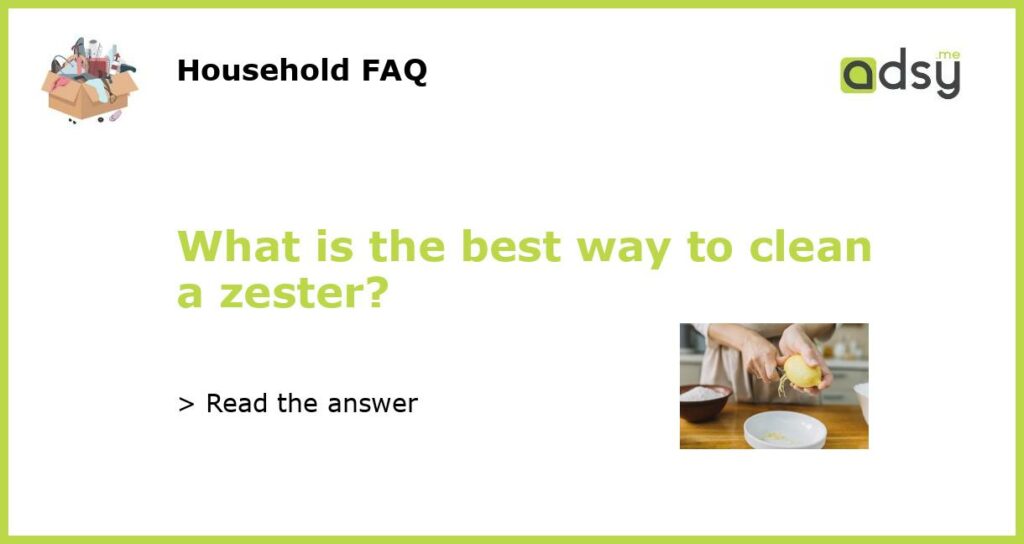The Importance of Cleaning Your Zester
Before we delve into the best way to clean a zester, let’s first understand why cleaning your zester is important. A zester is a culinary tool primarily used for grating the outer peel of fruits and vegetables to add flavor to various dishes. Over time, food particles and oils can accumulate on the zester, leading to a build-up of bacteria and affecting the flavor of future dishes. By properly cleaning your zester, you can ensure that it remains in optimal condition and prolong its lifespan.
Step-by-Step Guide to Cleaning Your Zester
Now that you understand the importance of cleaning your zester, let’s go through the step-by-step process to ensure a thorough clean:
- Step 1: Rinse with Warm Water – Start by rinsing the zester under warm running water to remove any loose food particles.
- Step 2: Use Dish Soap – Apply a small amount of dish soap to the zester and use a soft-bristled brush, such as a toothbrush, to gently scrub the surface. Pay attention to the small grating holes, ensuring that they are free from any residue.
- Step 3: Rinse Again – Rinse the zester thoroughly under warm water to remove any soap residue.
- Step 4: Sanitize – To sanitize the zester, you can either use boiling water or a mixture of equal parts water and white vinegar. Immerse the zester in the boiling water or vinegar solution for a few minutes to kill any remaining bacteria.
- Step 5: Dry – Finally, dry the zester thoroughly with a clean towel or leave it to air-dry before storing it in a dry place.
Tips for Cleaning Stubborn Stains on Your Zester
While the above steps should generally be sufficient for cleaning your zester, some stains and residue may be more stubborn to remove. Here are a few tips to help tackle those stubborn stains:
- Tip 1: Baking Soda – Create a paste by mixing baking soda with water and apply it to the stained areas of the zester. Let it sit for a few minutes before scrubbing it with a soft brush and rinsing it off.
- Tip 2: Lemon Juice – The acidic properties of lemon juice can help break down stains. Squeeze fresh lemon juice onto the stained areas and allow it to sit for a few minutes before rinsing it off.
- Tip 3: Vinegar – Similar to lemon juice, vinegar can be used to tackle stubborn stains. Soak the zester in a mixture of equal parts water and white vinegar for a few minutes before scrubbing and rinsing.
Noteworthy Considerations for Zester Cleaning
Here are a few additional considerations to keep in mind when cleaning your zester:
- Consideration 1: Dishwasher-Safe – Check if your zester is dishwasher-safe before cleaning it in the dishwasher. Some zesters may be made of materials that can be damaged or rusted in a dishwasher.
- Consideration 2: Immediate Cleaning – It’s best to clean your zester immediately after use to prevent any food particles from drying and hardening on the surface, making them more difficult to remove.
- Consideration 3: Storage – After cleaning your zester, ensure that it is completely dry before storing it. Moisture can lead to mold and mildew growth.
Regular Maintenance for Long-Term Zester Use
Cleaning your zester is just one aspect of maintaining it for long-term use. Here are a few additional tips to ensure your zester remains in excellent condition:
- Maintenance Tip 1: Sharpening – Over time, the blades of your zester may become dull. Consider sharpening them with a zester sharpener or using a fine-grit sharpening stone.
- Maintenance Tip 2: Storage – Store your zester in a dry and protected place to prevent damage and maintain its sharpness.
- Maintenance Tip 3: Handle with Care – Treat your zester with care, avoiding excessive force or banging it against hard surfaces. This will prevent it from bending or breaking.






